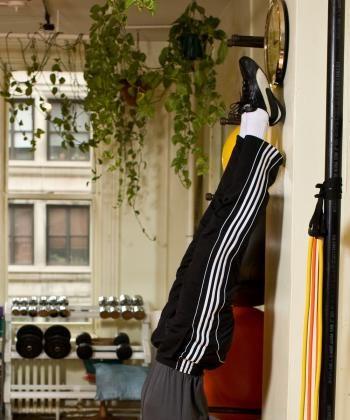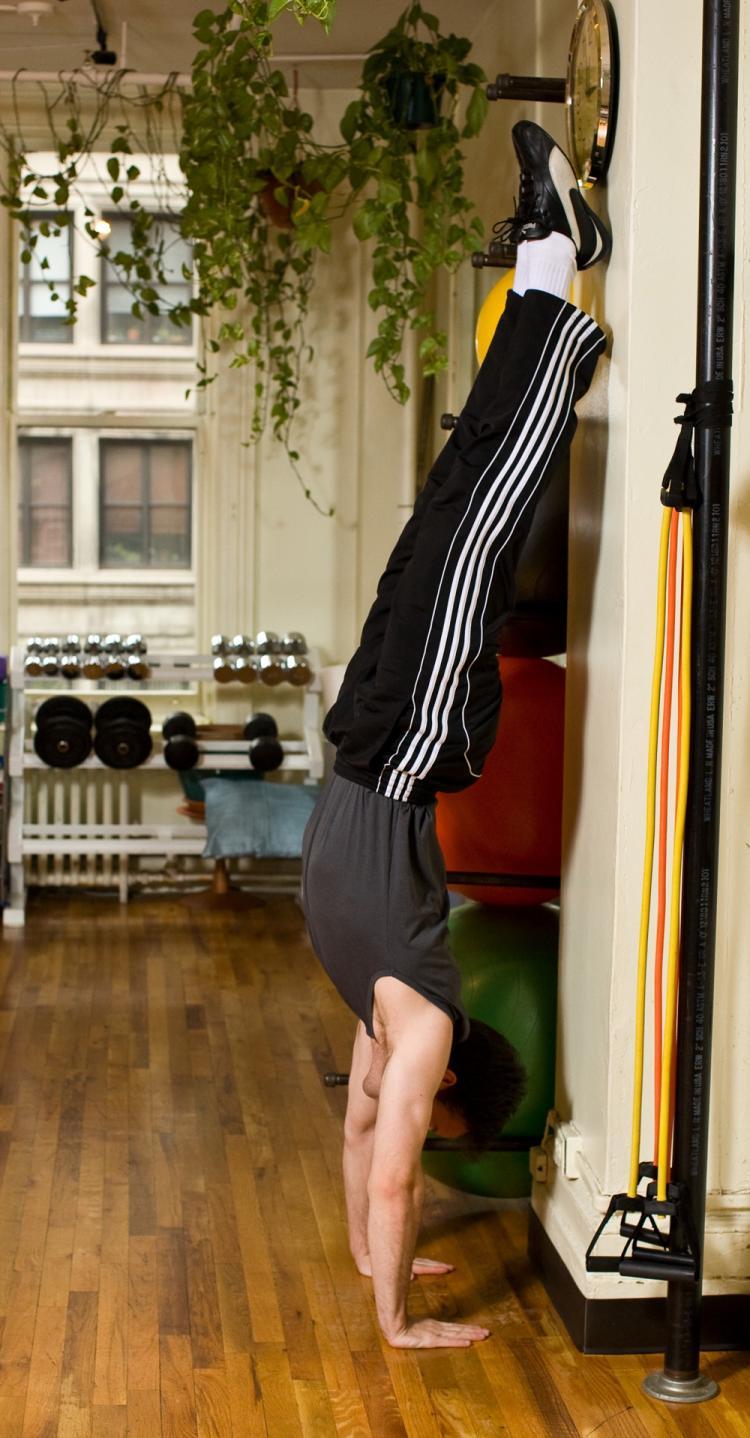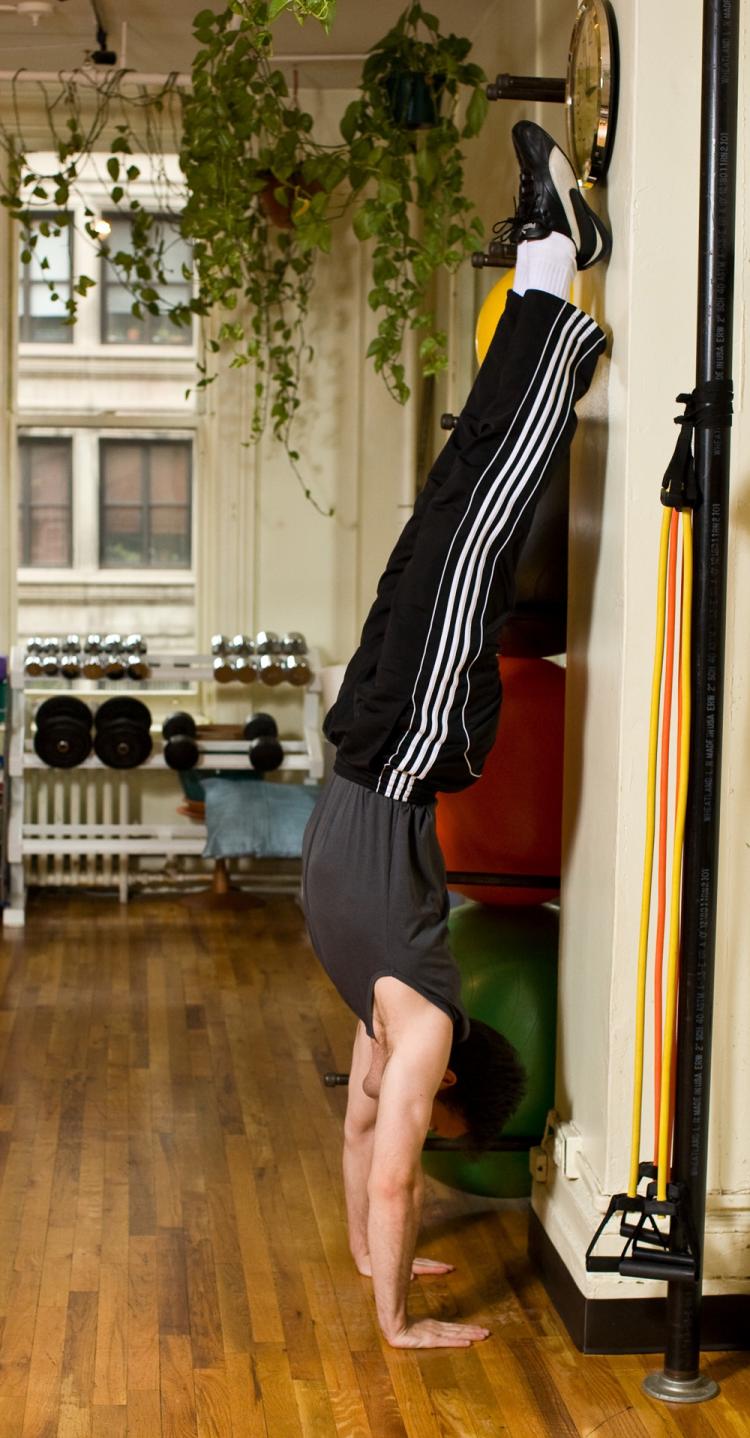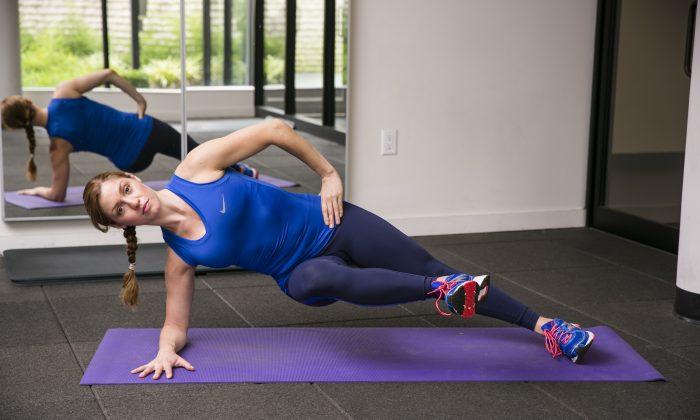The strong sense of accomplishment that one gets from mastering a handstand, let alone the rush it leaves behind, is great incentive to attempt what some may think of as a dreaded pose. Yoga teachers often approach the handstand as a means to get over the attachment to fear or the fear of failure.
Handstands do bring up that sense of putting yourself on the line. As you balance upside down you feel this gentle wave of your body. You must focus to remain centered, you must not follow the path of fear, or you will be sure to fall. You must be observant of the minor movements in your body, adjusting it continually to remain upright and balanced.
Of course, fear or any sentiment can’t always be forced out. Sometimes easing your way to success, one baby step at a time, is the most ideal process for success.
There are a few possible approaches to easing your way toward mastering a handstand. One is to spend time shifting your weight from your feet to your hands. Getting down onto all fours, walk across the floor as if crawling under a low brush of leaves. As you speed that walk up, you’ll find yourself sort of running across the space on all fours. This helps you get used to the sense of being on your hands. This is a fun and functional way to get used to being in your hands.
A handstand requires one to move and engage many muscle groups simultaneously. A young or novice gymnast must master a handstand, yet oftentimes, they are taught more challenging exercises prior to their mastery of the handstand. This encourages the development of muscular imbalances and faulty movement patterns. For those of us who are simply trying the handstand to improve our physical functioning, it is imperative that we find our centers and train ourselves properly.
To prepare your body to use its core functioning during the handstand, lie on the floor with the face down. Extend your arms straight above your head, palms down. Keep everything on the floor (palms, arms, chin, chest, hips, thighs, and feet) and draw your navel up, away from the floor. This elongates your lower back, the position it should be in during a handstand.
Next sit with your back against a wall and extend your legs straight out in from of you. Note where your heels touch the floor and place your hands in line with that spot. Spread your fingers and keep the palms of your hands flat on the floor. Kneeling on your knees, tuck your toes under and close enough to the wall so that your heels are lifted up onto it.
Slowly extend your legs as your hips lift toward the ceiling.
Walk your feet up the wall. Press your hands into the floor and push it away from yourself. Keep your thighs strong and knees straight. Pull in your naval as you did on the floor and tight your gluteus.
Perform these drills several times to train your body how to properly tilt your pelvis and strengthen your abdominal muscles effectively.
As you advance, move your hands closer to the wall and walk your feet up the wall. If you think you are ready to move into the full expression of the handstand pose, place your hands on the floor with your fingertips facing the wall. With the help of a spotter, kick your legs up toward the wall and balance there, with your heels resting against the wall and your hands pressing the floor down, elevating your body. Slowly test your balance, little by little. Before you know it, you will be upside down, fearless, and skilled with the experience of knowing how to conquer challenges, step by step.
Handstands do bring up that sense of putting yourself on the line. As you balance upside down you feel this gentle wave of your body. You must focus to remain centered, you must not follow the path of fear, or you will be sure to fall. You must be observant of the minor movements in your body, adjusting it continually to remain upright and balanced.
Of course, fear or any sentiment can’t always be forced out. Sometimes easing your way to success, one baby step at a time, is the most ideal process for success.
There are a few possible approaches to easing your way toward mastering a handstand. One is to spend time shifting your weight from your feet to your hands. Getting down onto all fours, walk across the floor as if crawling under a low brush of leaves. As you speed that walk up, you’ll find yourself sort of running across the space on all fours. This helps you get used to the sense of being on your hands. This is a fun and functional way to get used to being in your hands.
A handstand requires one to move and engage many muscle groups simultaneously. A young or novice gymnast must master a handstand, yet oftentimes, they are taught more challenging exercises prior to their mastery of the handstand. This encourages the development of muscular imbalances and faulty movement patterns. For those of us who are simply trying the handstand to improve our physical functioning, it is imperative that we find our centers and train ourselves properly.
To prepare your body to use its core functioning during the handstand, lie on the floor with the face down. Extend your arms straight above your head, palms down. Keep everything on the floor (palms, arms, chin, chest, hips, thighs, and feet) and draw your navel up, away from the floor. This elongates your lower back, the position it should be in during a handstand.
Next sit with your back against a wall and extend your legs straight out in from of you. Note where your heels touch the floor and place your hands in line with that spot. Spread your fingers and keep the palms of your hands flat on the floor. Kneeling on your knees, tuck your toes under and close enough to the wall so that your heels are lifted up onto it.
Slowly extend your legs as your hips lift toward the ceiling.
Walk your feet up the wall. Press your hands into the floor and push it away from yourself. Keep your thighs strong and knees straight. Pull in your naval as you did on the floor and tight your gluteus.
Perform these drills several times to train your body how to properly tilt your pelvis and strengthen your abdominal muscles effectively.
As you advance, move your hands closer to the wall and walk your feet up the wall. If you think you are ready to move into the full expression of the handstand pose, place your hands on the floor with your fingertips facing the wall. With the help of a spotter, kick your legs up toward the wall and balance there, with your heels resting against the wall and your hands pressing the floor down, elevating your body. Slowly test your balance, little by little. Before you know it, you will be upside down, fearless, and skilled with the experience of knowing how to conquer challenges, step by step.








Friends Read Free